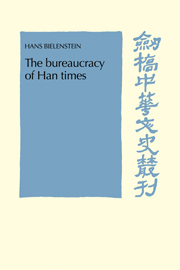Book contents
- Frontmatter
- Contents
- List of tables
- Preface
- Chronological table of emperors
- Abbreviations
- 1 The sources
- 2 The central administration
- 3 The local administration
- 4 The army
- 5 The salaries of the officials
- 6 Civil service recruitment
- 7 Power in government
- 8 Conclusion
- Notes
- Appendix: Official titles of the Han dynasties, Chinese–English
- Quoted literature
- Index
3 - The local administration
Published online by Cambridge University Press: 04 August 2010
- Frontmatter
- Contents
- List of tables
- Preface
- Chronological table of emperors
- Abbreviations
- 1 The sources
- 2 The central administration
- 3 The local administration
- 4 The army
- 5 The salaries of the officials
- 6 Civil service recruitment
- 7 Power in government
- 8 Conclusion
- Notes
- Appendix: Official titles of the Han dynasties, Chinese–English
- Quoted literature
- Index
Summary
The provincial staff
In the early years of the Former Han dynasty, scrutiny of local administration was the responsibility of Inspecting Secretaries (chien-yü-shih). These were replaced by Clerks (shih) from the ministry of the Chancellor who were dispatched from the capital at irregular intervals (HS 19A:27a), and whose exact nature is not identified by the texts. Most probably, they were drawn from the office of the Palace Assistant Secretary in the ministry of the Grandee Secretary, who ranked below the Chancellor. This would mean that the Clerks were identical with the Attending Secretaries (shih-yü-shih). It is a fact that the latter, at times, were sent out to uncover crimes and then were given the temporary title of Special Commissioners Clad in Embroidered Garments (hsiu-yi chih-chih) or [Attending] Secretaries Clad in Embroidered Garments (hsiu-yi [shih-] yü-shih) (see pp. 9–10).
In 106 B.C., the government for the first time appointed Inspectors (tz'u-shih) at the rank of 600 shih, one for each Province (chou). They were subordinates of the Palace Assistant Secretary, and through him the Grandee Secretary (HS 6:30a; 19A:5b, 27a–28a;HHS chih 28:1b). Nothing is known about the history of the provinces during Former Han previous to 106 B.C. So much is certain, that the number of Inspectors from that year on was thirteen (HHS chih 28:1b), so that there were thirteen provinces also. A fourteenth area of provincial size was the capital region, which from 89 B.C. or soon thereafter and until 9 B.C. was inspected by the Colonel Director of the Retainers (see p. 85).
- Type
- Chapter
- Information
- The Bureaucracy of Han Times , pp. 90 - 113Publisher: Cambridge University PressPrint publication year: 1980



